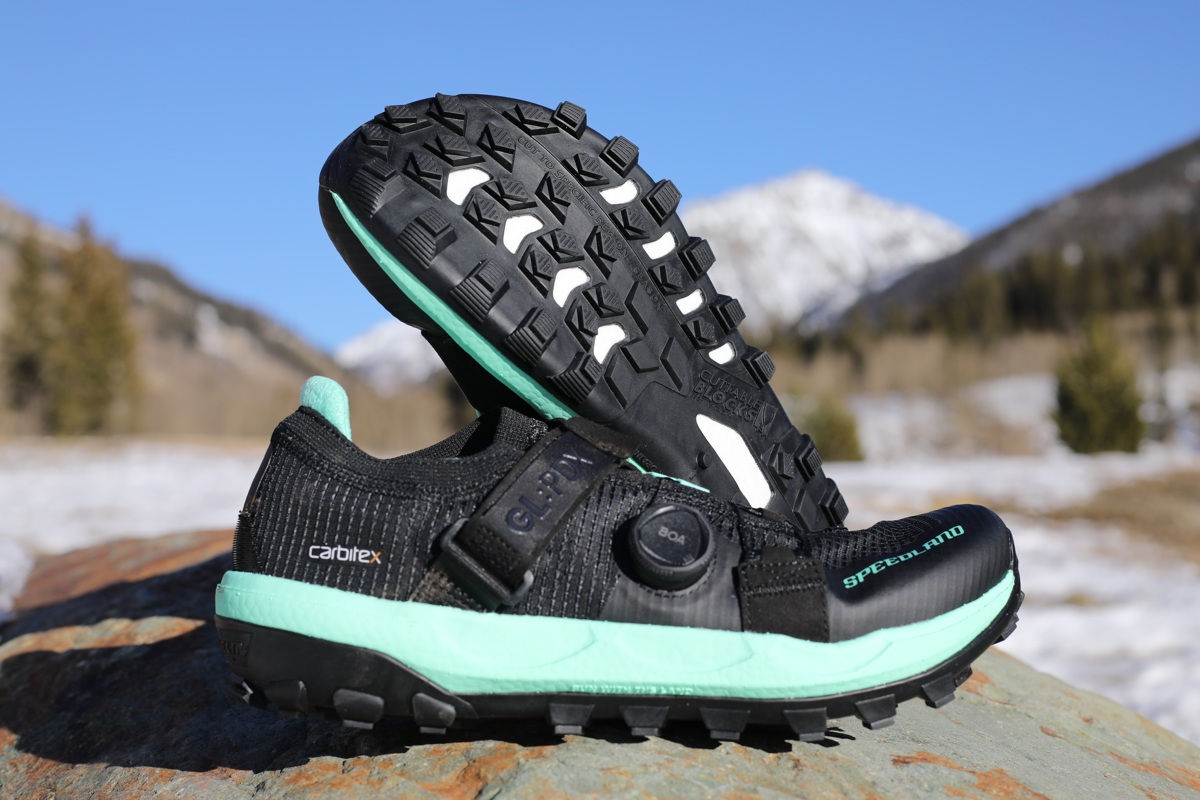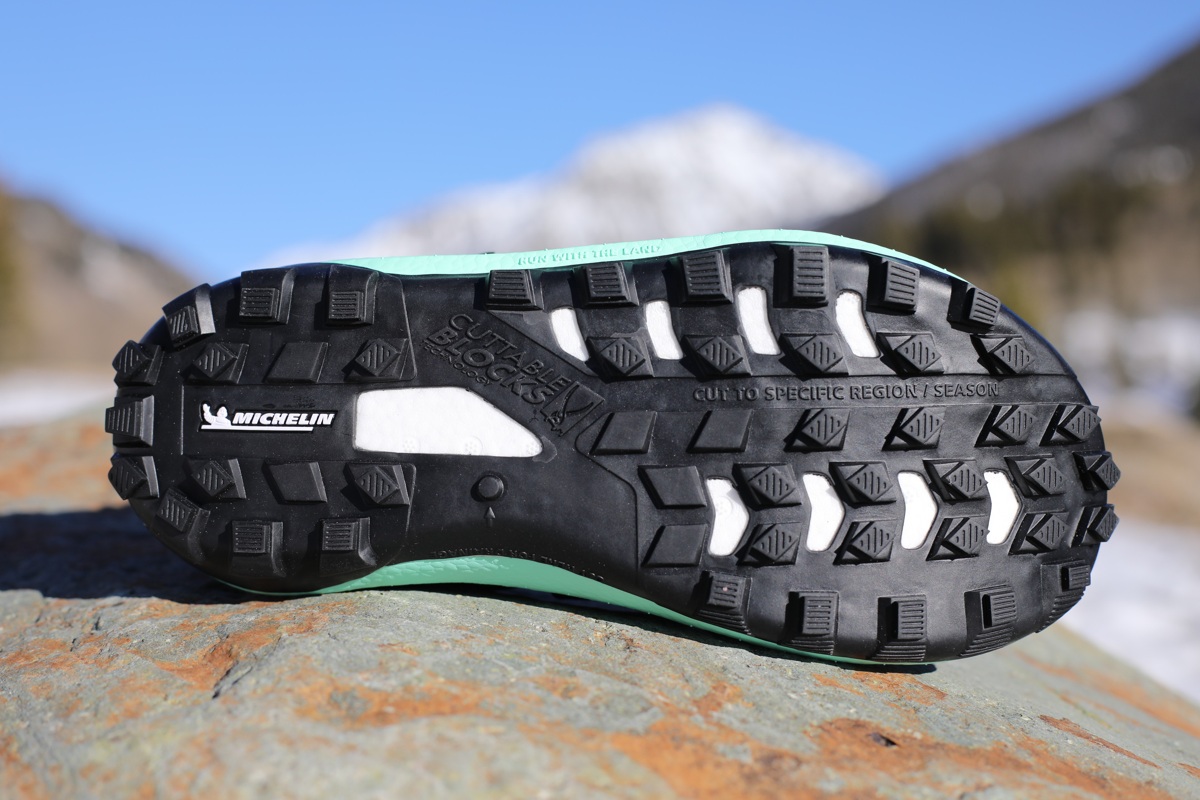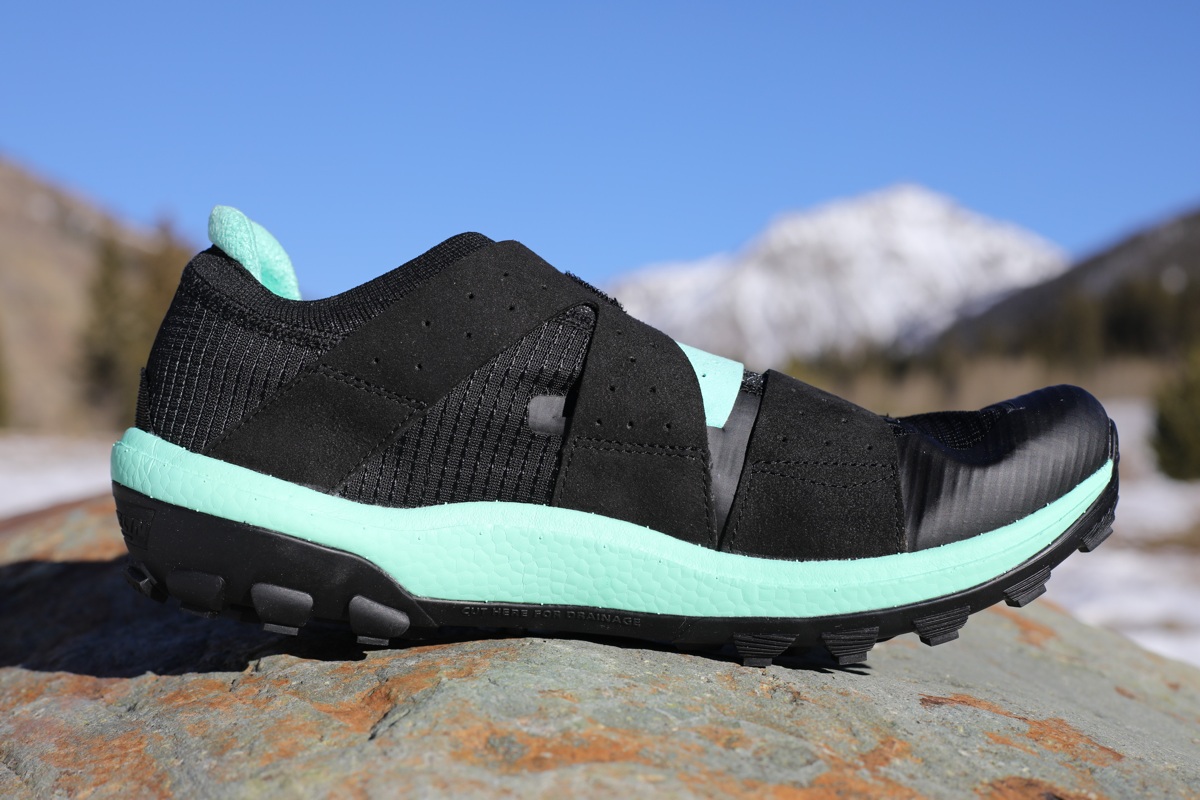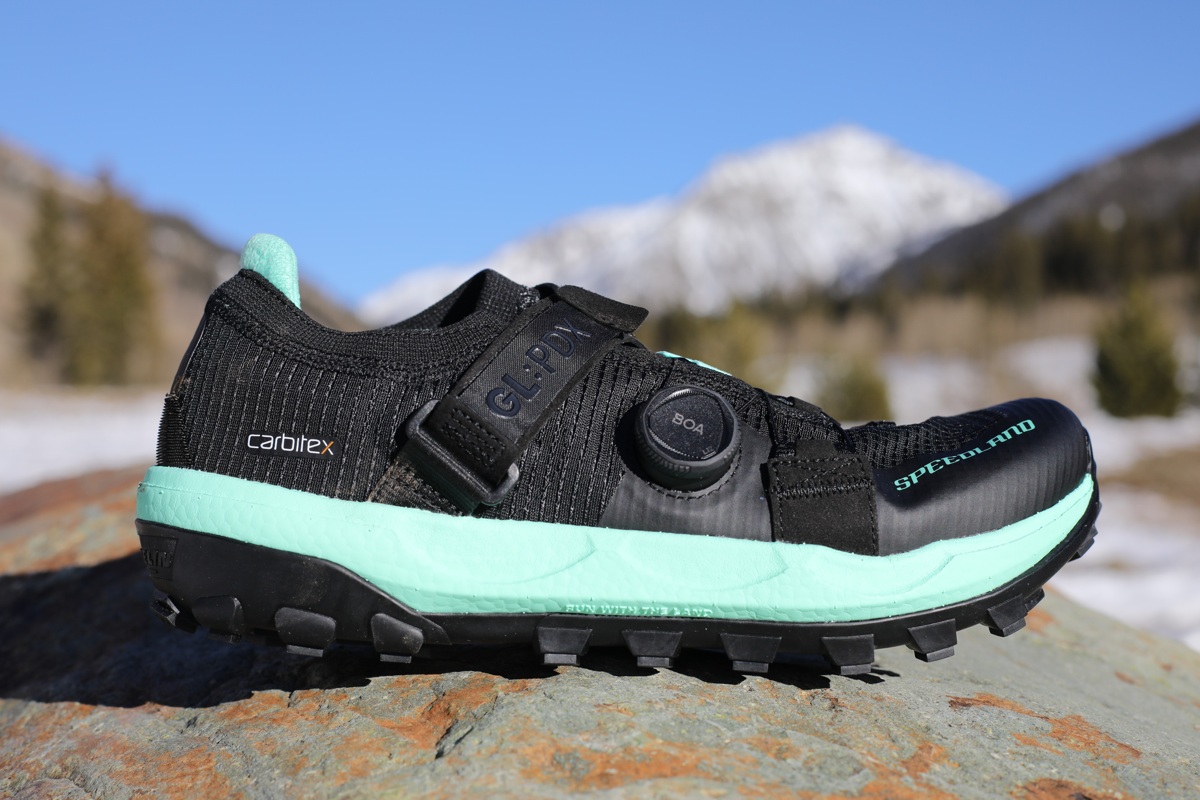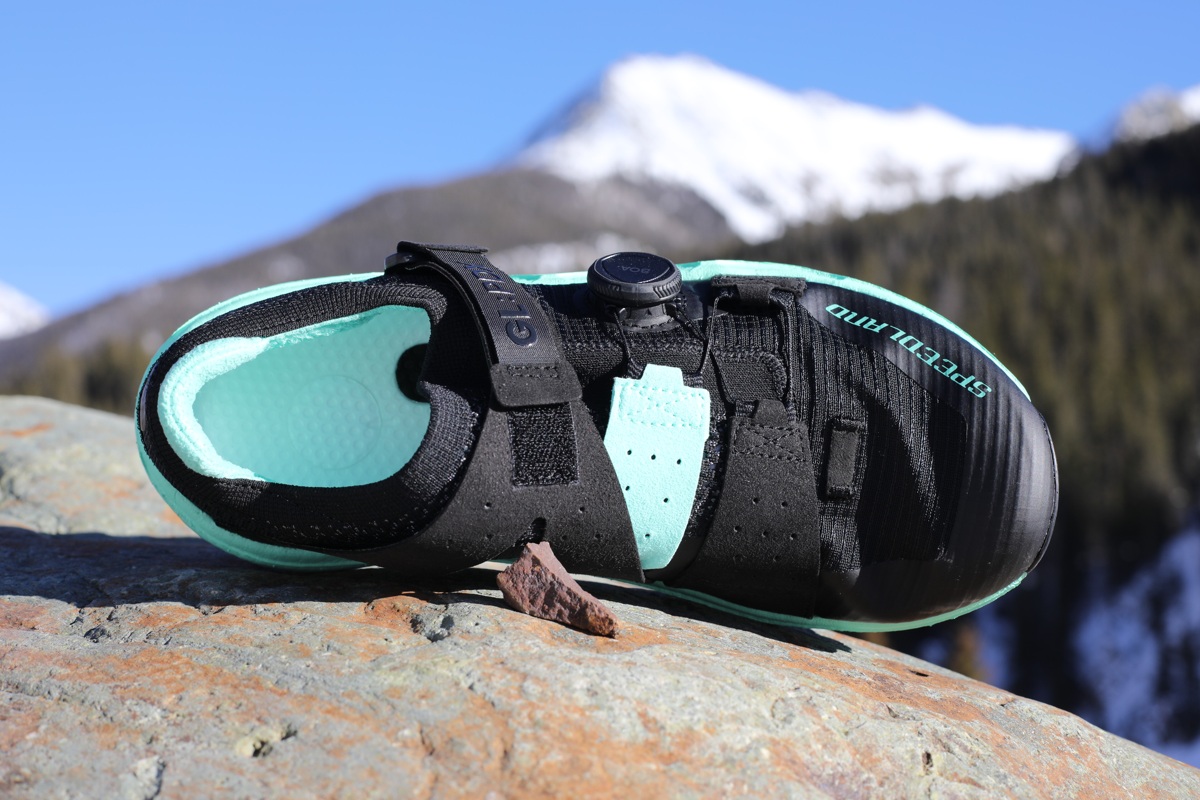The Speedland GL:PDX ($250) has a lower stack height and higher volume than many other shoes from the Speedland and offers exceptional comfort over longer distances. Equipped with a single BOA and a strap, the upper has a unique design that’s a departure from the brand’s more regular use of two BOAs. The Michelin rubber outsole provides plenty of grip on a variety of surfaces, and the 6.5-millimeter lugs are substantial enough to work in mud as well as drier trails. The shoe has an actual weight of 10.6 ounces (302 grams) for a U.S. men’s 9. With a stack height of 35 millimeters at the heel and 28 millimeters at the toe, it’s lower to the ground than other Speedlands. The shoe has a similar fit to shoes from Altra or Topo, but the 5-millimeter drop makes it more accessible than zero-drop shoes.
Even with the lower stack height, this shoe excels when the miles start to add up. The HTPU midsole combined with a thick insole sock liner makes for a comfortable ride, and the shoe’s higher volume allows feet to swell. The upper is a bit difficult to lock down, especially if you have a narrow heel, so this may not be a great shoe for extended miles on technical terrain.
iRunFar’s Travis Liles takes a deep dive into the Speedland GL:PDX and the conditions where it thrives.
Shop the Speedland GL:PDXSpeedland GL:PDX Review Transcript
Hey and welcome to Trail Trials, the video review section of iRunFar.com. My name is Travis Liles, and in this video, we’re going to take a look at the Speedland GL:PDX. Let’s check it out.
Alright, so let’s start off with the statistics. This is a 5-millimeter drop from heel to toe, coming in at 33 millimeters of stack at the heel, 28 at the toe. This is a unisex shoe in a men’s size 9, women’s 10.5. This is about a 10.5-ounce shoe. It has the BOA lacing both forward and backward. Instead of having two BOA dials, this one has a strap up here. It is the GL platform. Versus the Speedland GS line, the GL line is a little lower to the ground, a little shorter on the foam, maybe a little more narrow than that shoe. It’s kind of luggy and comes with this green colorway, the PDX edition. This is the color of the St. John’s Bridge. It’s supposed to take inspiration from Forest Park, which is a giant park right here in the city of Portland, where I actually ran a bunch of the miles of this shoe.
So, with all that said, let’s get up close and personal. Let’s see what this shoe is all about.
Speedland GL:PDX Outsole
Let’s start off by taking a look at the Speedland GL:PDX outsole here. The first thing you might notice is this is Michelin rubber, like the tire company. Even a little Michelin Man waving here on the bottom.
Overall, really good tread pattern and grip compound. I felt really good and confident when I was wearing these. You can see they’re pretty toothy. These are 6.5-millimeter lugs, which is fairly long, especially when you compare that to a lot of stuff out there that is a little more lower profile. These do bite. They do grip. When I wore these in wet and muddy-ish type conditions, I always felt like they gripped really well. No complaints on the rubber. Didn’t feel like they were slick. If I wore them for a road run and stepped on the white lines that get slick with organic material, especially here in Portland in the rainy season, these didn’t seem to have a problem sliding around on that, which is definitely not the case with all trail shoes.
I think overall, a really good tread pattern. It’s deep enough. It’s flexible enough on the bottom that the shoe kind of grips and molds. I think this shoe excels on the gravel-y, loose type of stuff versus the more mountain-y hard, but that has more to do with the fit, which I’ll talk about here in a second, and less to do with the compound. I think this is the first pair of shoes I’ve had with Michelin rubber, and I don’t have any complaints at all.
I think one other area of note is this little dot right here, and if we look closely here, it actually says to cut out for drainage. This shoe, as you can see, is buttoned up pretty tight. You’ve got some overlays and some other things here. If you’re going to be going in water a lot, and you want the shoe to drain better, it literally has a drain plug, which I think is kind of interesting. Obviously, once you pop this out, that’s the end of it, right? And you’re always going to have that hole there, but it lets water out. A couple of other things to note here. You can see this midsole poking through on the bottom. This is a 10.5-ounce shoe, so not heavy, not light, but that is one way that they’re saving some weight on the bottom. I never really noticed anything poking through in these areas, but obviously, those are slightly weaker spots that you might want to look out for because there’s not a rock plate in here.
Speedland GL:PDX Midsole
Ok, next up is the Speedland GL:PDX midsole. Being the GL line, this is a considerably shorter stack height. As I mentioned, it’s a 5-millimeter drop, so the drop is still pretty low. When you compare it to something like the GS line, the difference is pretty substantial when it comes to the size of the midsole. I’ll just pop in the Speedland GS:TAM here as an example. If you look at this green here, and then you look at this white here, it’s a considerable amount of additional material up here. Now, your foot does sit inside this GS:TAM a little bit more, but of the two, this is a lower-profile shoe that feels a little more controllable, feels a little more athletically fit.
And this is an HTPU midsole, which it’s similar in feel and kind of bounce to some of the Saucony shoes that have this styrofoam-y, pebble-y type of look. It’s got that same sort of feel. Very high rebound. Feels very cushioned. It is single-density foam all the way around. It’s not too tall, but it provides plenty of cushion without being over the top. This is probably a medium-cushion type of shoe, if I were to compare it to the industry at large.
The other thing I’ll have to call out on this is the way that the shoe leverages the midsole sock liner insert. You can see it’s very, very thick. This is amped up a little bit on the arch, but it’s very thick, and this is a big part of the midsole. This shoe can’t take insoles, if that’s what you’re into. These are specific to the shoe and really a big part of it, so this plays a big piece. These all play a part in this overall cushioning that you’re getting with the shoe.
And this is, again, similar to the Saucony Peregrine line that I’ve talked about. This entire sock liner here is made out of that same TPU-type of foam. It’s very high rebound, feels really good, and doesn’t wear down. There’s no pitting in here. This is meant to last a long time. I’d say as far as footbeds go, these are very high-end footbeds, at least in terms of durability. You’re not getting a bunch of places where the foam is busted out and getting flat, and those types of things. That’s just not what’s going to go on here, because this is definitely a midsole-type of foam that they’re using for that part.
The other thing I’ll note here is that there is a place to add a carbon plate, and so you get a view of that here. It simply snaps on here. It’s an additional part that you can order. It just sits down here in this sort of midsole, clips onto the bottom, and then you pop that back into the shoe, and you’ve got a shoe with a carbon plate on it. For that point I made earlier about some of these weak points, a carbon plate can be used for additional protection, but also for having a little more pep in your step, and adding some spring to your run. I wanted to call that out, even though it’s not midsole, it’s part of what Speedland considers their midsole technology.
Speedland GL:PDX Upper
Let’s take a look at the Speedland GL:PDX upper. Again, interesting concepts here. This has two things that are a little bit different than some of the other Speedland models, or I guess one thing that’s different. The BOA is very, very common, of course, on these shoes, and the way that the BOA system works is pretty simple.
This is a two-way BOA, so you can pull this out, and that gives you all of your stretch here. You can see that the cords come out, and then you push this in, and you’re able to put your foot in, twist that down, and you can see the shoe getting tighter.
Now what’s interesting about this is that it also goes the other way, and so if we pop out, we get a little more space. For lack of a better term, dial this in. These wires sort of crisscross, and they go over these two pieces of fabric over here. These are a little bit gross from the weather here, but you can see these things are going to come across. One’s connected right behind the back of your big toe, and this one’s a little bit more through that arch area of your foot. You’re going to get this sort of squeeze down here at the bottom, and it adds a really consistent pull. It’s putting a connection between this side of the shoe, the medial and lateral parts of the shoe, and creating a bit of a wrap here. I actually really liked that part of this shoe and the way that it fit.
The other thing here is this upper strap, and this is not common. The other GL model does not have this, and the GS:TAM doesn’t have this either. This is a strap that you can pull down and pull across. It has a couple of areas that it connects to at the back part of the heel, across the top of your foot, and again on the arch inside of your foot, and pulling that across.
What I will say is that, in general, the lower part of this shoe, I was able to really lock down. The upper part of this shoe, I wasn’t. The majority of it is, I use upper eyelets on my shoes to tie them and to really create a lock. You can’t really create a lock, because there’s nothing here that pulls these things together. It’s more that you’re creating pressure here, but the heel is still sort of independent. It brings all this together by creating tension here and here that sort of pulls this together. It’s more in the front.
Now, does it work? Sure, but if it’s over really technical stuff, this is not really my favorite type of fit, but if you’ve got a higher volume foot, maybe it works just fine. Just for comparison, I’ll show you the GS:TAM. The first thing I’ll call out is the lacing system. This one has two dials versus one. Again, they’re the same type of thing, but this dial goes up higher, so you’re trading a dial for this strap. I don’t know that one does anything different necessarily than the other, but just worth calling out. I felt like this strap worked better than the secondary dial. Neither one of them was really super, super locked down for me in the upper part. The bottom part of the foot was just fine.
Ok, let’s call out another couple of things here. On the upper, there’s some stretchy material down here on the foot. It is a fairly wide fit across the shoe, so even though this is a more narrow fit than the GS:TAM that I just showed, there’s still quite a bit of room in here. I would compare this to a Topo or an Altra in the fit, that it’s a little bit wider. It’s a little bit more comfortable. It’s a shoe that you can just sort of slide your foot into really easily, especially if these things aren’t locked down and just sort of like have it hanging off your foot. And then, of course, you can do all these various things here to lock it down, but it’s a very comfortable type of fit. Plenty of room for your toes. There’s stretchy fabric here at the top that has kind of just enough movement in it. Doesn’t make your toes feel too locked in.
And then there are overlays on the front to keep the water out and those types of things. And then, as you move across the back, you see the same type of engineered material all the way around. This calls out the carbon plate that you can put in the shoe. For the most part, it’s really a very fabric-y, unstructured, not too bad, upper. The only thing that adds structure here is that you’ve got this hard, little BOA thing here. If you’ve got a sensitive part of your foot and you really have to lock this thing down, that could be a problem. I actually experienced that on the GS:TAMs. I didn’t experience that at all on this shoe.
The last thing I’ll call out here is the heel collar. It is a structured heel collar from here down, and there’s a little gaiter attachment there. There’s some pads in here, but to my point about this strap, I was never able to fully lock it down to the fit that I exactly wanted with these mechanisms.
The last thing I want to show is the width of what you’re getting into between these two models. Because again, the Speedland series goes GL and GS, and those platforms arrange different. This is a top-down view of the GS:TAM, and you can see that it is significantly wider. These are both men’s 9.5s, but the amount of volume that is different between these two is pretty significant. I would probably say almost an inch in width if you were to go from this here to this here. Just something to keep in mind, if you’ve got a really wide foot, you’ve got options here. I would still say this is a more generous fit than a lot of shoes, but you do have options in the way that these things fit. And of course, with the BOA systems, you’ve got a way to dial it down.
Speedland GL:PDX Overall Impressions
In closing, what does the Speedland GL:PDX do really well? This shoe does really well on more groomed, fire road, gravel, stuff that doesn’t have a lot of twists and turns and technical terrain on it. Because just for my heel, I can’t get it to lock down the way that I want, despite this nice midfoot wrap and even this strap across the top. It alleviated the pressure that I had with the GS:TAM, with the dials pushing on my foot, but I still was never able to lock it down enough. There just wasn’t enough here, in this space, because it’s kind of loose and floppy. And again, you don’t have upper eyelets, which I always use on all of my shoes. Some shoes I even add upper eyelets to. So hopefully that gives you a little bit of extra knowledge on where my foot fits in.
This is a fat tire bike. That’s what I feel like about these shoes. When I was on longer distance, gravel-y, kind of groomed or dirt type trail, this thing just loped and did its thing and felt really good. My foot could expand, and the grip felt really good on the bottom of it. And it was comfortable with this nice foam, and this really thick midsole, and really thick insole that’s in there as well. It just really performed well on that. Where it didn’t perform well is where I wanted my foot to be locked in, and I just couldn’t ever quite get that.
So, who’s this for? I’d say if you’re doing a bunch of technical terrain and you’ve got a narrower heel, this might not be exactly it. And I don’t know if any of the Speedland models are it if you’ve got a low-volume foot and a narrow heel, because it’s just hard to get it locked in, despite having all these cool dials and things like that. If you’ve got a more high-volume foot that takes up a lot of space and you’re into Altras and Topos and that style, these might actually work even better because you can get a little bit more dialed-in fit in these than some of those types of shoes. Plus, you’re not fighting a zero-drop, this being at a 5-millimeter drop.
So overall, lots of cool stuff on this shoe. It’s comfortable. Does really great on that less technical terrain, longer distance. Seems to be holding up really well. The insole is super thick. The midsole is really comfortable. It grips well. There are all kinds of fun customizations. Like you can add a carbon plate. You can pop holes out of this to let the shoe drain. There’s a lot of technology and a lot of ideas thrown in here, which I think is just fun for the industry in general. Bonus that it’s PDX colors, and I live in Portland.
Any questions, comments, place those below this video. Thanks for watching. We’ll catch you next time.
Shop the Speedland GL:PDXCall for Comments
- Have you had a chance to run in the Speedland GL:PDX? What were your impressions?
- Are you a fan of BOA dials on trail running shoes?
Our Favorite Trail Running Shoes
Learn more about our current favorite trail running shoes in our Best Trail Running Shoes guide.
